Intestinal accumulation of microbiota-produced succinate caused by loss of microRNAs leads to diarrhea in weanling piglets
- PMID: 35758253
- PMCID: PMC9235893
- DOI: 10.1080/19490976.2022.2091369
Intestinal accumulation of microbiota-produced succinate caused by loss of microRNAs leads to diarrhea in weanling piglets
Abstract
Diarrheal disease is a common health problem with complex causality. Although diarrhea is accompanied by disturbances in microbial diversity, how gut microbes are involved in the occurrence of diarrhea remains largely unknown. Here, using a pig model of post-weaning stress-induced diarrhea, we aim to elucidate and enrich the mechanistic basis of diarrhea. We found significant alterations in fecal microbiome, their metabolites, and microRNAs levels in piglets with diarrhea. Specifically, loss of ssc-miRNA-425-5p and ssc-miRNA-423-3p, which inhibit the gene expression of fumarate reductase (frd) in Prevotella genus, caused succinate accumulation in piglets, which resulted in diarrhea. Single-cell RNA sequencing indicated impaired epithelial function and increased immune response in the colon of piglet with diarrhea. Notably, the accumulated succinate increased colonic fluid secretion by regulating transepithelial Cl-secretion in the epithelial cells. Meanwhile, succinate promoted colonic inflammatory responses by activating MyD88-dependent TLR4 signaling in the macrophages. Overall, our findings expand the mechanistic basis of diarrhea and suggest that colonic accumulation of microbiota-produced succinate caused by loss of miRNAs leads to diarrhea in weanling piglets.
Keywords: Diarrhea; microRNAs; microbiome; piglets; succinate.
Conflict of interest statement
The authors report there are no competing interests to declare.
Figures







References
Publication types
MeSH terms
Substances
LinkOut - more resources
Full Text Sources
Molecular Biology Databases
